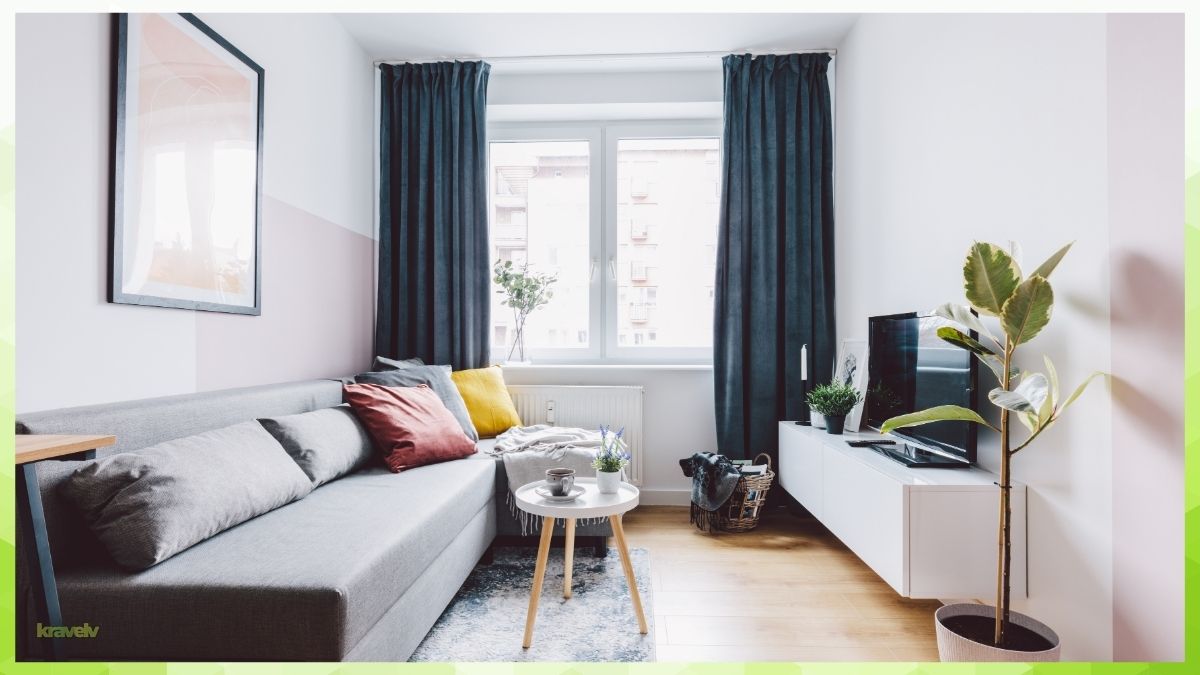Last Updated on April 20, 2025 by Kravelv Spiegel
Small apartments may come with limitations, but with the right approach, they offer endless opportunities for creative design. From multi-use furniture to vertical storage tricks, the most effective design ideas for small apartment living are about thinking smarter—not smaller. The way we arrange, furnish, and decorate tight spaces can completely transform how we live in them. Whether you’re decorating your first studio or downsizing intentionally, small space design can still be high on function and style.
💡Key takeaways:
- Multi-functional furniture and vertical storage solutions are essential for maximizing utility in small apartments.
- Strategic zoning, lighting, and layout techniques help create the feel of multiple rooms in one space.
- A thoughtful mix of colors, textures, mirrors, and layered lighting can make a small apartment feel larger and more inviting.
- Personalization without clutter—through intentional décor and smart storage—transforms limited space into a comfortable, expressive home.
1. Choose Furniture That Works Overtime
In a small apartment, every piece of furniture should earn its place. Multi-functional furniture doesn’t just save space—it helps you live more efficiently.
Some smart picks I often recommend:
- A daybed or sleeper sofa in a studio that becomes a bed at night and a lounge by day.
- A dining table that folds down or doubles as a work desk.
- Ottomans with hidden compartments—great for stashing away remotes, books, or seasonal items.
- A platform bed with built-in drawers to replace bulky dressers.
These pieces simplify your layout and cut back on clutter while still keeping the space beautiful.
2. Think Vertically: Floor-to-Ceiling Opportunities
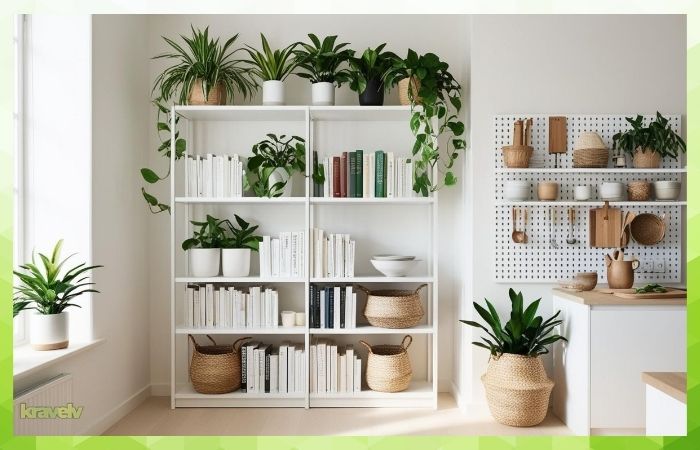
When square footage is tight, the walls become your best friend. I encourage clients to shift their mindset from “What fits here?” to “What fits up here?”
Here are a few vertical upgrades that pack a punch:
- Tall bookcases with baskets on the top shelf for less-used items.
- Wall-mounted desks or vanities that keep floor space clear.
- Hooks and pegboards in the kitchen or hallway—perfect for storing tools, bags, or even hanging plants.
- Over-the-door storage racks or tiered shelves in bathrooms.
This not only increases storage but draws the eye upward, making ceilings feel taller and the space more open.
📖Also read: 25 Vertical Shelving Ideas for Small Spaces
3. Divide Without Walls: Create Distinct Living Zones
Just because your apartment lacks walls doesn’t mean your life needs to blur into one giant “everything” space. Whether you’re living in a studio or a micro-loft, defining zones helps your space feel intentional—not chaotic.
Tried-and-true zoning methods I use:
- Rugs to anchor living and sleeping areas.
- A folding screen or open bookshelf to subtly divide your bed from your home office.
- Ceiling-mounted curtains that you can pull closed for privacy or ambience.
- Lighting variations—warm floor lamps in the living area, pendant lighting over the dining zone, and task lamps in your work nook.
Clear zoning is about creating functional rhythms, not physical barriers.
4. Go Light with Color, but Layer Like a Pro
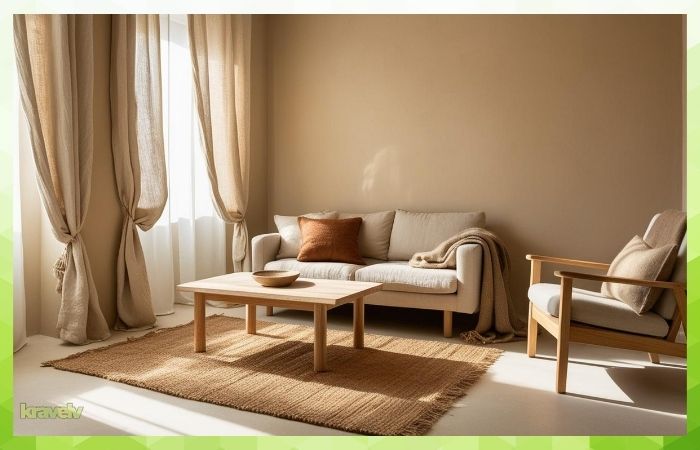
Light colors visually expand a room, but layering prevents things from looking flat. Here’s the sweet spot I aim for with small apartment palettes:
- Stick to a neutral base: soft white, pale gray, or creamy beige on walls.
- Add muted tones like sage green, dusty rose, or sand through throws, art, and upholstery.
- Introduce texture via jute rugs, linen curtains, woven baskets, and velvet cushions.
One client once told me her tiny space felt “relaxing but rich”—that’s what the right layering does. It adds warmth, character, and depth without visual overload.
5. Reflect and Brighten with Mirrors and Glass
Mirrors do more than help you check your outfit. They bounce light around the room and double your visual space—without taking up an inch of floor space.
Here’s how I incorporate them:
- Hang a large mirror opposite a window to maximize natural light.
- Use a gallery-style wall of small mirrors as functional art.
- Install mirror-fronted cabinets in the bathroom or entryway.
- Opt for glass or acrylic furniture that keeps sightlines open and the space airy.
If you don’t have great natural light, add warm LED bulbs in multiple zones and let your mirrors amplify the glow.
6. Scale Furniture to Your Space—But Don’t Go Too Small

Here’s a common mistake: downsizing furniture too much. Tiny furniture may seem like the logical choice for a small space, but it often makes the room feel cluttered.
Instead:
- Choose well-proportioned furniture with clean lines.
- Go for sofas with slim arms and legs that show the floor beneath.
- Use a round table in a tight dining area to increase flow.
- Place tall items in corners to make ceilings feel higher.
One large statement piece (like a full-sized sofa) often works better than a bunch of miniatures.
7. Design a Functional Entryway—Even If You Don’t Have One
Small apartments rarely come with proper foyers. Still, the first few feet of your home deserve attention.
Some ways I’ve created entry moments:
- Add a narrow floating shelf to hold keys, mail, or a small plant.
- Mount hooks or a rail above for bags, hats, and jackets.
- Layer a rug and mirror to ground the area and make it feel complete.
- Use a slim bench with storage for shoes or umbrellas.
This small design effort prevents chaos from creeping into the rest of the apartment and makes your home feel more pulled together.
8. Layer Your Lighting—Don’t Rely on One Bulb
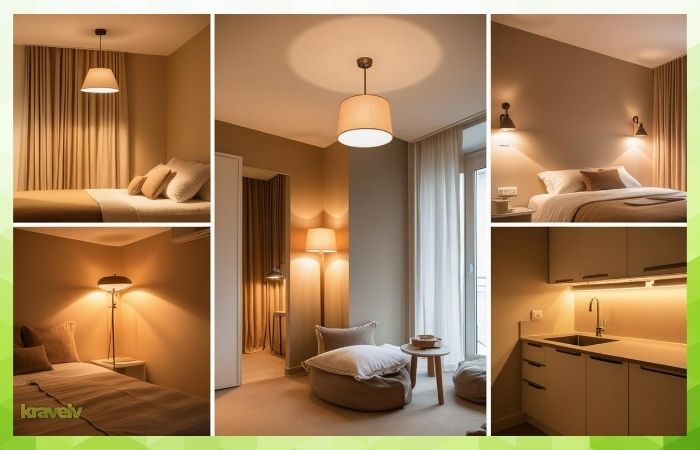
Lighting makes or breaks a small apartment. Overhead lights alone won’t cut it. I always tell clients: think in layers.
Here’s the breakdown:
- Ambient light: floor lamps or ceiling pendants to set the tone.
- Task lighting: a desk lamp, under-cabinet lighting, or bedside sconces for focused work or reading.
- Accent lighting: LED strips behind furniture, candles, or string lights to add mood and warmth.
In a small space, well-placed lighting also helps with zoning—making one room feel like many.
9. Consider Modular or Custom Storage
Custom work may sound expensive, but smart modular systems can achieve the same effect. I’ve used IKEA pieces, floating cabinetry, and renter-friendly solutions to fit awkward corners and turn dead zones into highly functional areas.
Try:
- Wall-mounted cabinets in tight kitchens or hallways.
- A rolling cart that tucks into unused corners and moves between kitchen and living room.
- Modular closet systems that adapt as your needs change.
Storage doesn’t need to be bulky. The right solution will blend into your space while keeping your life organized.
10. Add Meaningful Personality Without Clutter
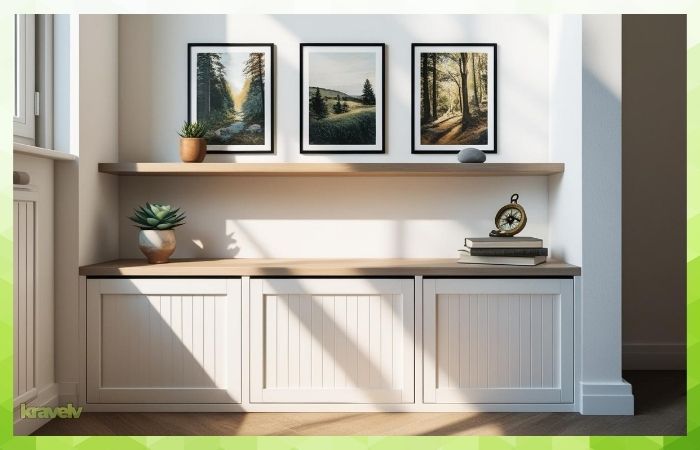
The best small apartments aren’t just organized—they’re personal. But personalization can quickly turn into clutter if you’re not intentional.
Tips I live by:
- Rotate your décor seasonally—store what’s not in use.
- Use closed storage for practical items, and open shelves for decorative touches.
- Frame personal photos, artwork, or travel mementos for display walls.
- Bring in a few low-maintenance plants to freshen up the atmosphere.
Instead of asking, “Where can I put more stuff?” ask, “What story do I want this room to tell?”
Bonus Tip: Embrace Visual Breathing Room
Here’s one of the most underrated small apartment design tricks—leave some space empty.
Negative space (aka white space) gives the eyes somewhere to rest and the brain a break. If every wall, shelf, and corner is filled, your home can quickly start to feel cramped, even if it’s stylish.
Try this:
- Keep one wall blank or nearly blank.
- Limit the number of decorative pieces per surface.
- Step back and ask yourself what you can remove.
Less isn’t just more—it’s sometimes essential.
Design ideas for small apartment FAQs
How can I make my small apartment look bigger?
Use mirrors, light paint colors, and open furniture layouts to create the illusion of more space.
What furniture works best in a small apartment?
Choose multi-functional furniture such as sofa beds, storage ottomans, and fold-out tables to save space without sacrificing comfort.
What’s the best way to organize a studio apartment?
Define zones using rugs, curtains, or furniture placement, and utilize vertical storage to keep surfaces clear.
Can I personalize my small apartment without cluttering it?
Yes—opt for a few meaningful pieces, rotate décor seasonally, and store non-essentials out of sight.
What color scheme works best for small apartment interiors?
Light neutrals like white, beige, or soft gray are great for opening up a space, while textures and accent tones add depth.
Final words
Designing a small apartment isn’t about restrictions—it’s about creativity. When you combine functionality with personal flair, small spaces can feel surprisingly expansive and incredibly satisfying to live in.
With the right design ideas for a small apartment, you’re not just maximizing square footage—you’re building a home that fits your lifestyle and reflects your personality.
And remember, it doesn’t all have to happen at once. Start with one area, make it work for you, then build from there.

